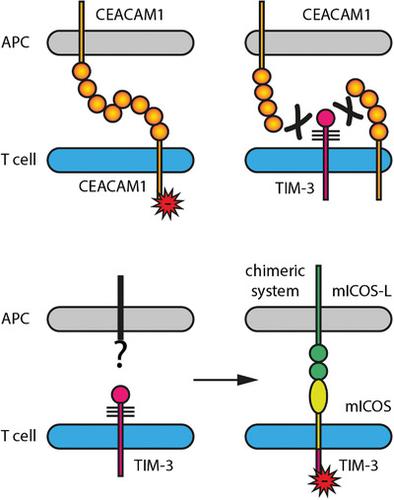当前位置:
X-MOL 学术
›
Eur. J. Immunol.
›
论文详情
Our official English website, www.x-mol.net, welcomes your
feedback! (Note: you will need to create a separate account there.)
TIM-3 and CEACAM1 do not interact in cis and in trans.
European Journal of Immunology ( IF 4.5 ) Pub Date : 2020-03-29 , DOI: 10.1002/eji.201948400 Annika De Sousa Linhares 1 , Florian Kellner 2 , Sabrina Jutz 1 , Gerhard J Zlabinger 3 , Hans-Joachim Gabius 4 , Johannes B Huppa 2 , Judith Leitner 1 , Peter Steinberger 1
European Journal of Immunology ( IF 4.5 ) Pub Date : 2020-03-29 , DOI: 10.1002/eji.201948400 Annika De Sousa Linhares 1 , Florian Kellner 2 , Sabrina Jutz 1 , Gerhard J Zlabinger 3 , Hans-Joachim Gabius 4 , Johannes B Huppa 2 , Judith Leitner 1 , Peter Steinberger 1
Affiliation

|
TIM‐3 has been considered as a target in cancer immunotherapy. In T cells, inhibitory as well as activating functions have been ascribed to this molecule. Its role may therefore depend on the state of T cells and on the presence of interaction partners capable to perform functional pairing. Carcinoembryonic antigen‐related cell adhesion molecule (CEACAM1) has been proposed to bind TIM‐3 and to regulate its function. Using a T cell reporter platform we confirmed CEACAM1‐mediated inhibition, but CEACAM1 did not functionally engage TIM‐3. TIM‐3 and CEACAM1 coexpression was limited to a small subset of activated T cells. Moreover, results obtained in extensive binding studies were not in support of an interaction between TIM‐3 and CEACAM1. Cytoplasmic sequences derived from TIM‐3 induced inhibitory signaling in our human T cell reporter system.
中文翻译:

TIM-3和CEACAM1不以顺式和反式相互作用。
TIM-3被认为是癌症免疫治疗的靶标。在T细胞中,抑制和激活功能已经归因于该分子。因此,其作用可能取决于T细胞的状态以及取决于能够进行功能配对的相互作用伴侣的存在。已提出癌胚抗原相关细胞粘附分子(CEACAM1)结合TIM-3并调节其功能。使用T细胞报道分子平台,我们确认了CEACAM1介导的抑制作用,但CEACAM1在功能上并未参与TIM-3。TIM-3和CEACAM1共表达仅限于活化T细胞的一小部分。此外,在广泛的结合研究中获得的结果并不支持TIM-3和CEACAM1之间的相互作用。源自TIM-3的细胞质序列在我们的人类T细胞报告系统中诱导了抑制性信号传导。
更新日期:2020-03-29
中文翻译:

TIM-3和CEACAM1不以顺式和反式相互作用。
TIM-3被认为是癌症免疫治疗的靶标。在T细胞中,抑制和激活功能已经归因于该分子。因此,其作用可能取决于T细胞的状态以及取决于能够进行功能配对的相互作用伴侣的存在。已提出癌胚抗原相关细胞粘附分子(CEACAM1)结合TIM-3并调节其功能。使用T细胞报道分子平台,我们确认了CEACAM1介导的抑制作用,但CEACAM1在功能上并未参与TIM-3。TIM-3和CEACAM1共表达仅限于活化T细胞的一小部分。此外,在广泛的结合研究中获得的结果并不支持TIM-3和CEACAM1之间的相互作用。源自TIM-3的细胞质序列在我们的人类T细胞报告系统中诱导了抑制性信号传导。











































 京公网安备 11010802027423号
京公网安备 11010802027423号